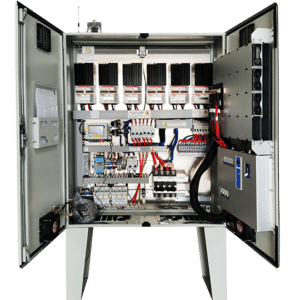
Output Power: 300 Watts
Input Voltage: 115/230V; 50/60 Hertz
Batteries: 12 | Volt
Today’s telecom infrastructure is increasingly located in remote, isolated areas—from mountain tops to desert regions— which are usually far from any electrical grid and rely on on-site power generation to operate. But between fuel and maintenance costs, generators are expensive to own and operate. For communications providers, the ultimate goal is to establish self-sustainable mobile networks with higher efficiency and profitability and remain competitive in a lower Average-Revenue-Per-User (ARPU) environment.
That’s why telecommunications providers—both wireless service providers as well as BTS tower operators– are turning to solar PV and PV/Hybrid (PV + a secondary energy source) power solutions to achieve their business objectives. Unlike generators and wind turbines, photo-voltaic (PV) solar has no moving parts—so consequently, no downtime. And solar electric systems never need fueling or an overhaul. This type of system can be sized and installed as the primary source of power for a remote telecom site, and the hydro, wind, and/or generator-based systems can supplement PV output should “days of autonomy” be insufficient for the installation’s powering needs.
As more of the telecommunications industry shifts to solar, Morningstar’s extensive line of solar controllers and accessories are more frequently found at the core of their systems. In such a system, the charge controller is both “heart and brains” of the outfit, controlling the PV/solar-generated electricity flowing from the panels, or modules, into batteries for storage as well as the DC output to power connected loads, maintaining both system operation and battery health.
In remotely powered telecommunications installations, what matters most is efficiency and reliability. Efficiency is paramount for systems that may need as much autonomy as possible to get through long stretches without sunlight or refueling. Morningstar’s proprietary TrakStar solar harvesting technology and fanless design make for inherently more efficient systems. And with over four million Morningstars installed in the field since 1993, there’s no brand in the solar industry that’s more proven or accepted in terms of reliability.
If you aren’t sure which option is right for you, use our contact form to request a consultation with one of our staff to recommend the appropriate products for your application. Use our How To Buy form to request specific products from our inventory.

The Apollo Series solar and hybrid energy solution delivers reliable and sustainable energy management for any telecom site incorporating solar and battery storage. It can be deployed in a retrofit application to add solar and battery storage to existing site infrastructure or for network expansion to new sites. Apollo was designed from its inception to integrate with existing site hardware including diesel generators, rectifiers or legacy battery systems.
The Apollo Series solar and hybrid energy solution is highly refined – already in it’s 5th Generation – and extensively proven across 1000’s of sites globally. It is engineered specifically for unattended, remote sites in harsh high-temperature environments where downtime is unacceptable. Throughout 30 years of designing ultra-efficient power electronics into solar and hybrid energy applications for telecom we’ve helped thousands of customers achieve unparalleled uptime – while refining a customizable energy management platform to meet virtually all tower site requirements utilizing solar and battery storage.
Simple Network Management Protocol (SNMP) is a secure local and remote monitoring capabilities through a modern, complex network incorporating Ethernet switches and wireless access points (WAPs).

Sunlight is converted into DC electricity in the solar modules or panels.
The DC electricity from the panels flows into a charge controller, which both provides perfect battery charging and powers DC-operated loads.
Smaller systems and systems with consistent sunlight (little shading or seasonal variation) usually feature PWM (pulse-width modulation) charge controllers, which are simple and reliable. Larger systems and systems where there is variation in sunlight due to seasonal changes or shading often use MPPT (maximum power point tracking) charge controllers, which are more complex but also are more effective at harvesting solar electricity.
The solar charge controller keeps working—by preventing any “reverse current” flowing from the batteries to the PV modules, and (if equipped with load control) disconnect power to the loads if the battery voltage dips too far, which can quickly kill batteries.
Watch the recorded webinar to see how Morningstar solar controllers are used in a variety of off-grid telecommunications applications throughout the world.
From densely populated urban centers to remote isolated areas far from any electrical grid, solar electricity makes telecommunication operations easier and more cost-effective.
© Morningstar Corporation